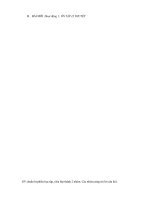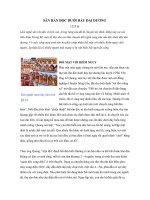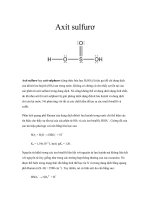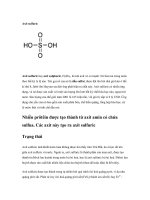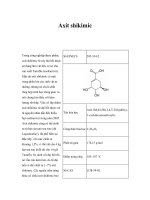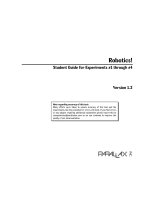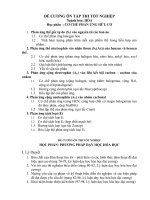Tài liệu PROTECTIVE COATINGS doc
Bạn đang xem bản rút gọn của tài liệu. Xem và tải ngay bản đầy đủ của tài liệu tại đây (237.92 KB, 22 trang )
3. CLASSIFICATION AND PROPERTIES OF PAINT
3.1 Some basic chemistry
3.2 Classification
3.2.1 Physically drying
3.2.1.1 Solvent-borne paints
3.2.1.2 Waterborne paints
3.2.2 Chemically curing
3.2.2.1 Oxidative curing
3.2.2.2 Two-component curing
3.2.2.3 Other curing mechanisms
3.3 Classification Diagram
3.4 Properties of Individual Binder Types
3.4.1 Physically drying
3.4.1.1 Solvent-borne paints
• Tars and Bitumen
• Chlorinated rubbers
• Acrylics
• Vinyls
3.4.1.2 Waterborne paints
3.4.2 Chemically curing
3.4.2.1 Oxidative curing
• Alkyds
• Modified Alkyds
3.4.2.2 Two-component curing
• Epoxy
• Polyurethane
3.1 PROTECTIVE COATINGS
TRAINING
3.4.2.3 Other Film-forming Mechanisms
• Humidity curing
• Zinc Silicates (ethyl)
• Polyurethane (one-pack)
• Carbon Dioxide curing
• Zinc Silicates (alkali)
• Heat curing
• Silicone
3.1 Some basic chemistry
The properties of the binder in the paint mainly determine the film-forming properties of
a paint (ref. 2.2.1).
A binder is always built up of small units (monomers) to a larger unit, the polymer. If
the polymer consists of more than one type of monomer, it is called a copolymer. If the
polymer is built up of the same monomer, it is called a homopolymer. The number of
monomers in a polymer can vary from 5 to as much as 3500, and in connection with
paint the number is often quite high.
In a dried and/or cured paint film the binder is either found as a bunch of long chains
(the polymer chains) or as closely knitted networks (the polymer chains are connected
by cross-linking).
polymer chains polymer chains
with cross-linking
The size and shape of the binder polymer will influence the properties of the final paint
film. Longer chain molecules and denser network structures will increase toughness and
resistance in the resulting binder, while smaller molecules will result in the best
penetration into the substrate.
3.2 PROTECTIVE COATINGS
TRAINING
3.2 Classification, based on type of binder
The manner in which paint films are formed is determining for many of the key
properties of a paint film. This is the reason why paints are often classified according
to their film formation principles.
Film formation can take place in one of two ways:
• physically drying
• chemically curing
3.2.1 Physically drying
In physically drying paints the binder molecules in the dry paint film are already
present in the wet paint. There is no change in binder composition or molecule
structure and size. The paint film is formed entirely by evaporation of solvents (a
physical process), leaving the binder molecules as chains coiled up and
intertwined in the coating.
Binders of importance to the paint industry are:
3.2.1.1 Solvent-borne paints
The binders are dissolved in solvents, both the natural binders such as
tar and bitumen and the synthetic types like chlorinated rubber,
acrylic and vinyl.
Film formation
Solvents evaporate. Binder molecules are intertwined and attracted to
each other and to the substrate.
3.3 PROTECTIVE COATINGS
TRAINING
3.2.1.2 Waterborne paints (dispersions)
Water-borne paints are dispersions of small binder particles in water.
Very large binder molecules can be incorporated in the binder phase by
utilising the dispersion technology.
Used in a solvent-borne paint the same size of molecules would result
in too high viscosity, or if diluted to the same viscosity, in a very low
solid content.
Film formation
Water evaporates. The binder particles deform and coalesce (or melt
together) assisted by coalescing agents (powerful solvent for the binder
particles) - until they form a continuous film, attached to the surface.
Properties common to physically drying paints:
Ò Solvent borne
• Reversible, ie the coating, even months or years after application,
is soluble in its own or more powerful solvents. Solvent
molecules penetrate in between the binder molecules, push them
apart and dissolve the binder.
Solvent sensitive; consequent to being reversible, these paints are
not resistant to their own or stronger solvents.
• Temperature independent for film formation, since no chemical
reactions are involved in the film formation.
• Thermoplastic, ie physically drying coatings become soft at
elevated temperatures. Like other molecules, the polymers
become more mobile at higher temperatures and, as they are not
3.4 PROTECTIVE COATINGS
TRAINING
cross-linked to each other, they have a certain freedom of move
-
ment, resulting in a softening of the coating.
• Excellent recoatability.
Ò Waterborne
• Reversible to a certain degree, as the coalescing agent or
solvents of the same or stronger dissolution power will be able to
re-dissolve the paint film; however, just adding water will not
result in a re-dispersion of the paint film. Re-dispersion is never
possible.
• Solvent sensitive; consequent to the above, solvents similar or
stronger in dissolution power to the coalescing agent in question
will be able to attack the coating.
• Temperature dependent for film formation, the softening point
where the binder particles are able to melt together, is normally
5°C or slightly higher, minimum application temperature is 10°C.
• Thermoplastic, as for solvent-borne paints.
• Excellent recoatability.
3.2.2 Chemically curing
In chemically curing paints the final binder molecules in the dry/cured paint film
are not present in the wet film. The smaller "wet" molecules will during and after
application take part in a chemical reaction whereby new, larger binder
molecules are formed. The film is formed by the cross-linking of the molecules
(polymerization) and often by the evaporation of solvents also.
Binders of importance to the paint industry are:
3.5 PROTECTIVE COATINGS
TRAINING
3.2.2.1 Oxidative curing
Binders which are most often dissolved in solvents and which form the
final binder with oxygen in the air, eg oleoresins, alkyds, modified
alkyds.
Film formation
3.2.2.2 Two-component curing
Binders which are often dissolved in solvents and consist of two
components that react with each other after mixing, forming the final
binder, eg epoxy, polyurethane, unsaturated polyester.
Film formation
3.6 PROTECTIVE COATINGS
TRAINING
3.2.2.3 Other curing mechanisms
Binders can be formed by other chemical reactions or polymerisation
processes, eg
• Reaction between binder molecules and water present as humidity in
the air like zinc ethyl silicate and one-pack polyurethane.
• Reaction between binder molecules and carbon dioxide in the air
like sodium, potassium and lithium zinc silicates (alkali zinc
silicates).
• Reaction triggered off by high temperature as in the case of silicone
by curing for a few hours at 200°C.
Properties common to chemically curing paints:
• Irreversible, ie the cured coating is not dissolvable.
• Resistant to solvents (consequence to being irreversible).
• Temperature dependent on film formation as the rate of the chemical
reaction taking place during curing is directly related to temperature,
ie there is a temperature limit below which film formation will not
take place.
• Non-thermoplastic. The binder molecules in the tight cross-linking
are not able to vibrate or move even at high temperature, ie the paint
film does not become softer at higher temperatures.
• Critical recoating interval. Recoating must take place before
complete curing has taken place. If curing is completed, the surface
must be mechanically roughened before application of new paint.
3.7 PROTECTIVE COATINGS
TRAINING
3.3 Classification Diagram
(most important binder types only)
Polyurethane
Zinc Ethyl Silicates
Zinc Alkali Silicates
Silicones
Others
Epoxies
Polyurethane
Polyesters
Two-pack
Oleoresinous
Alkyds
Modified Alkyds
Oxidation
Chemically
curing
Acrylics
Vinyl acetate copolymer
Vinyl chloride copolymer
Styrene-butadiene copolymer
Waterborne
Chlorinated Rubbers
Acrylics
Vinyl
Tars
Bitumen
Solvent borne
Physically
drying
P
A
I
N
T
P
A
I
N
T
P
A
I
N
T
or as presented in the family tree:
3.8 PROTECTIVE COATINGS
TRAINING
3.4 Properties of Individual Binder Types
The following is a survey of some of the more important binders used in coatings for the
protection of marine and industrial structures. The properties listed are general and may,
for the actual coating, vary somewhat according to formulation and possible
modification.
3.4.1 Physically drying
3.4.1.1 Solvent-borne paints
Tars and Bitumen
Coal tars are obtained by distillation from coal, formerly from
gasworks, but today, mainly from steel works. They consist of a mixture
of liquid tar oils and solid coal tar pitches.
Bitumen is more often than not the heavy residues from oil distillations
though it may still be found in nature.
As opposed to most other binders used for protective coatings, coal
tars and bitumen are often used without pigmentation. Their high content
of carbon make them virtually opaque and black.
Tars and bitumen are low cost barrier coatings, often specified behind
linings and as maintenance coating in ballast tanks.
General advantages and limitations of tars and bitumen are:
• Excellent water resistance
• Poor weathering, will crack when exposed to sunlight (due to
evaporation of low boiling oils)
• Fair chemical resistance
• Poor solvent resistance
• Excellent penetration and adhesion
• Low cost
• Give rise to bleeding; ie small molecules (the low boiling tar oils)
will migrate to the surface and cause discoloration of any non-black
topcoat
• Black or very dark colours only
3.9 PROTECTIVE COATINGS
TRAINING
Due to the excellent water resistance of coal tar, it is often used in
combination with other binders, epoxy, vinyl and polyurethane.
Chlorinated Rubbers
As the name indicates chlorinated rubber resin is formed by adding
chlorine to rubber. In the early days only isoprene from natural rubber
was utilised but, nowadays, most of the isoprene is extracted in the oil
industry.
After application and the evaporation of its solvent, chlorinated rubber
leaves a dense but very brittle film. A softening agent, a plasticizer, is
therefore always incorporated in a chlorinated rubber-based paint.
Chlorinated rubber-based paints are used extensively as anticorrosive
coatings, coatings for concrete and other alkaline substrates.
General advantages and limitations of chlorinated rubber coatings are:
• Good water resistance
• Relatively good weathering
• May yellow and chalk (chlorine content causes yellowing)
• Fair chemical resistance
• Good alkali resistance
• Poor resistance to animal and vegetable oils and fats
• Contain plasticizers (and many properties may depend upon the type
of plasticizer used)
• Contain chlorine (hydrochloric acid is formed at elevated tempera-
tures such as when welding, burning, cutting, etc.)
Acrylics
Acrylic resins are produced by polymerising different acrylic mono-
mers. Through the use of different monomers the properties of the
acrylic resin can be varied to a very large extent. Properties are also
influenced by the often incorporated plasticizer.
Used on exterior steel work above the waterline.
General advantages and limitations of acrylic coatings are:
3.10 PROTECTIVE COATINGS
TRAINING
•
Relatively good water resistance
• Good weathering
• Good colour retention
• Low to fair resistance to animal and vegetable oils and fats
• Usually only fair wetting properties
• Contain plasticizers
• May contain chlorine (in plasticizer)
Vinyl
Vinyl resins are mainly based on a copolymer consisting of vinyl
chloride monomers and vinyl acetate monomers, but other monomers
can occur too.
Vinyl form fairly brittle films, so plasticizers might be incorporated
into vinyl-based paints.
Vinyl-based paints are used on exterior steel work, and when combined
with tar extensively used as anticorrosive primer.
General advantages and limitations of vinyl coatings are:
• Good to excellent water resistance
• Good weathering
• Good chemical resistance
• Resistant to weak solvents
• Fair resistance to animal and vegetable oils and fats
• Usually only fair wetting properties
• Relatively quick drying
• Relatively low solid content and, consequently contain high amount
of (strong) solvents
• May contain chlorine (causes yellowing, forms hydrochloric acid at
elevated temperatures)
Other kinds of polymerisation than the previously mentioned exist,
where less strong solvents are used to liquefy the binder; their chemical
resistance is lower and they are not solvent resistant. Polyvinyl- butyral
(PVB) is one of these kinds of polymerisation, where the absence of the
monomer vinyl chloride and thereby absence of chlorine in the binder
makes it suitable for shopprimers (welding, cutting).
3.11 PROTECTIVE COATINGS
TRAINING
3.4.1.2 Waterborne paints
General advantages and limitations of dispersions are:
• Contain only limited amount of high boiling solvents (the coalescing
agent)
• No flash point
• Sensitive to high humidity during application
• Sensitive to low temperatures during storage and application (water
may freeze)
• Poor levelling
Additional properties can be obtained by combining various monomers
into different copolymers as indicated below.
Vinyl acetate copolymer
Used in combination with various plasticizing monomers, vinyl acetates
are mainly used in house paints.
Special properties:
• Relatively good water resistance
• Relatively good colour stability
• Low cost
Acrylic copolymer
The type and number of different acrylic monomers in an acrylic binder
can vary extensively, resulting in tailor-made properties for each
specific binder.
Acrylic-based paints are used as house paint (especially exterior) and
wood varnish.
As indicated, properties of acrylic binders can be very different, but in
general they have
• Good water resistance
• Good colour retention
• Good gloss retention
• Good adhesion to a variety of different substrates
3.12 PROTECTIVE COATINGS
TRAINING
Polyurethane
The reaction product between isocyanate and the hydroxyl containing
binder, ie the polyurethane (ref . 3.4.2.2), is present as complete binder
particles in the dispersion. Paints based on a polyurethane dispersion
are consequently one-component products.
They are used as sole binder or in combination with acrylic as wood
varnish, floor varnish or paint, and paints for plastics.
Special properties are:
• Good adhesion to plastics
• Good abrasion resistance
• Limited resistance to outdoor exposure
• High cost
Vinyl chloride copolymer
Used in combination with plasticizing monomers, eg vinylidene
chloride and acrylic.
Can be used as an anticorrosive primer on steel.
Special properties are:
• Good water resistance
• Yellowing
Styrene butadiene copolymer
A ratio of approximately 60% styrene monomer and 40% butadiene
monomer is used as binder in anticorrosive high-builds, on areas not
exposed to sunlight.
Special properties are:
• Good water resistance
• Gets brittle and yellow when exposed in UV-light (sunlight) and
oxygen from the air
• Comparatively low cost.
3.13 PROTECTIVE COATINGS
TRAINING
3.4.2 Chemically curing
3.4.2.1 Oxidative curing
The key component of paints forming film by an oxidation process, is a
drying oil. Drying oils are natural products, eg linseed oil, soya oil or
fish oil. Drying oil consists of fatty acids combined with glycerol. By
reacting the fatty (drying oil) acid with other components, larger and
more complex molecules are formed, eg phenolic varnishes and alkyd
resins, having more durable properties.
Alkyds
Alkyds are often referred to as being short, medium or long oil alkyds.
Short oil alkyds contain less than 40% fatty acid and are mainly used in
coatings for production-line application. Medium oil alkyds contain
from 40-60% fatty acid, and long oil alkyds more than 60%.
Alkyd paints are used on exterior steel work (above waterline) and in
interior dry rooms.
General advantages and limitations of medium oil alkyds are:
• Poor water resistance after long periods of exposure
• Reasonable to good weathering
• Reasonable to good gloss retention
• Reasonable colour retention
• Poor alkali resistance
• Solvent is mineral spirits, a comparatively weak solvent
• Good penetration and adhesion.
Modified Alkyds
Alkyds may be modified with a wide range of other binders to provide
new binders with specific properties.
3.14 PROTECTIVE COATINGS
TRAINING
Typical modifications are:
• Styrenated alkyd. Copolymerising alkyd with styrene gives an
alkyd which is faster drying, more chemical and water resistant, but
less tolerant of poor surface preparation.
• Urethane alkyd. Isocyanate modified alkyd resin improves the
drying somewhat, and the components are usually selected to
provide additional hardness. Often used for primers required to
withstand rough handling. Due to their good through-drying proper-
ties, they are favoured as binders in high-builds.
• Silicone alkyd. When the silicone content exceeds 30%, silicone
alkyd is durable and retains it's gloss. Especially used for finishing
coats exposed to intense sunlight.
• Epoxy ester. Epoxy ester is sometimes, but wrongly, referred to as
a one-component epoxy. Epoxy ester is a drying oil modified with
epoxy. This hard synthetic resin is faster drying and has better water
and alkali resistance than alkyds, but it chalks and is comparatively
expensive.
Epoxy esters exhibit good adhesion and good anticorrosive proper-
ties; often used for primers required to withstand rough handling or
forced drying at elevated temperatures.
3.15 PROTECTIVE COATINGS
TRAINING
3.4.2.2 Two-component curing
Binders in this group form their films through a polymerising reaction
between two components, usually referred to as base and curing agent
or hardener, which are mixed together immediately prior to applica-
tion.
Epoxy
Epoxy may cure at normal room temperatures through the addition of
curing agent (certain amines or poly amides, or adducts
1
) of the same).
The curing agent reacts with the epoxy groups in the base resin, build-
ing a three-dimensional network (ref. 3.2.2.2).
Certain epoxies containing hydroxyl-groups react with isocyanates,
resulting in low temperature curing properties. The cured film is hard
and wear resistant, but chalks rapidly if exposed to sunlight. This
detracts from the cosmetic appearance, but usually it does not have any
influence on the protective value of the coating.
Amides are the most versatile curing agents, giving ease of application
and good water resistance, while amines provide better chemical resis-
tance, but give shorter pot life and overcoating intervals. Low tempera-
ture curing properties are obtained when curing with adducts or
isocyanates.
Epoxy resins may be produced in different molecular sizes, of which
the smallest are liquid at normal room temperature. These are the
so-called low molecular weight epoxies, used for solvent-free and
solvent-less epoxies.
Epoxy-based paints are specified for the exterior and interior of steel
work, in tanks, as heavy duty and high-build coatings.
General advantages and limitations of epoxy coatings are:
• Good to excellent water resistance
• Good weathering (apart from chalking)
• Tendency to chalking
• Good physical properties, such as toughness, flexibility and abrasion
resistance (especially the solvent-free versions)
• Good heat resistance, up to 120°C in continuous dry service
3.16 PROTECTIVE COATINGS
TRAINING
1
Pre-reacted amines/poly amides with minor parts of epoxy still leaving reactive
groups in the hardener.
• Good to excellent chemical resistance (best for amine cured
epoxies)
• Good adhesion to a wide range of materials
• Two-pack (attention to mixing and pot life)
• Curing is temperature dependent.
• Coal Tar Epoxy
Selected coal tars may be mixed with epoxy resin to make coal tar
epoxy; the addition of coal tar lowers the cost and improves water
resistance.
Since coal tar epoxy first emerged on the market, it has proven itself
to provide the optimum in water resistant coatings systems.
Used as an anticorrosive system below the waterline, and in ballast
tanks.
The solvent resistance of coal tar epoxy is not altogether perfect, and
weathering properties are poor. It has a tendency to bleed into
subsequent coats and recoating intervals are very critical. This may
lead to intercoat adhesion problems unless great care and discipline
is exercised during application.
Polyurethane (two-pack)
Polyurethane is formed through a reaction between isocyanates and
hydroxyl containing binders (eg alcohols), creating a network structure.
They are usually two-pack products, have better weathering properties
and cure at lower temperatures than epoxies (ie in general down to
-10°C, epoxies normally down to 5-10°C). During the curing process
however, polyurethane is much more sensitive to humidity. (The curing
agent, isocyanate, can react with water, resulting in foam in the applied
paint film).
The isocyanates are either aromatic (ie containing a benzene ring) or
aliphatic (without the benzene ring). Both types give tough, wear resis-
tant films with good resistance to chemicals and solvents.
Aromatic isocyanates dry faster than aliphatic, but when used externally
they chalk and yellow rapidly.
Aliphatic isocyanates possess superior colour retention and UV resis-
tance (ie the ultraviolet radiation in sunlight); they are frequently
recommended for exterior finishing coats.
3.17 PROTECTIVE COATINGS
TRAINING
Like epoxies, polyurethane may be produced in a wide range of
molecular sizes, some small enough to allow their use in solvent-free
or solvent-less coatings.
Polyurethane is used as a finishing coat above the water line in epoxy
systems, heavy duty coating, floor and boat finishes.
General advantages and limitations of polyurethane coating are:
• Excellent weathering
• Excellent gloss retention (aliphatic types only)
• Excellent colour retention (aliphatic types only)
• High abrasion resistance
• Good chemical resistance
• Difficult application (low relative humidity and trained painters
required)
• Low temperature curing
• Two components (attention to mixing and pot life)
• Comparatively expensive.
3.18 PROTECTIVE COATINGS
TRAINING
3.4.2.3 Other Film-forming Mechanisms
Humidity curing
Humidity curing binders polymerise and form films through a reaction
with water, usually in the form of vapour contained in the surrounding
air. Binders of interest are ethyl silicate and moisture curing (one-
pack) polyurethane.
• Ethyl silicate dries by the loss of solvent, alcohol, and cures by a
reaction between the silicate and the humidity in the environment.
Since ethyl silicate is used predominantly for zinc silicate coatings,
and its properties, when cured, are similar to those of alkali
silicates, the potassium, sodium and lithium zinc silicates, it is
included with these carbon dioxide curing alkali zinc silicates.
• Polyurethane (one-pack)
The tendency of the isocyanate group to react with water can be
utilised by employing isocyanates with relatively large molecules.
After application the paint or varnish cures by absorbing moisture
from the air.
Moisture curing polyurethane has properties similar to two-pack
polyurethane. Its major limitation is its dependence on humidity in
the surrounding air, plus special care should be exercised in their
storage when they are pigmented - as pigments may contain a certain
amount of moisture.
Also, the production of moisture curing polyurethane is an exceed-
ingly tricky business. Manufacture often has to take place under a
"nitrogen blanket", to avoid humidity coming in contact with the
binder until curing is desired.
Carbon Dioxide Curing
• Zinc Silicates
Silicate binders owe their special properties to a high content of
silicon-oxide in their composition. In the protective coatings field,
silicate binders are exclusively pigmented with zinc as zinc
silicates. As such they offer the best corrosion protection obtainable
with a paint.
Lithium, potassium and sodium silicates dry by the loss of water and
cure by:
3.19 PROTECTIVE COATINGS
TRAINING
a)
a reaction between zinc and silicate, and
b) a reaction between silicate and carbon dioxide in the air
Sodium silicate is, and potassium silicate may be, post-cured. That
is, after drying, the application of an accelerator (a water-based acid
solution) accelerates the curing, which may otherwise take as long
as 5-8 days.
General advantages and limitations of zinc silicate coatings are:
• Excellent weathering
• Excellent abrasion resistance (alkali silicates superior)
• Excellent heat resistance (up to 400°C)
• Resistant within the pH range of 6-9 only
• Excellent solvent resistance
• Require surface preparation of very high standard, both as
regards cleanness and surface profile
• Demanding application conditions (temperature, humidity,
continuous stirring and film thickness)
• Critical recoating (risk of popping and/or poor adhesion)
• Excellent corrosion prevention (through galvanic effect).
Heat curing
• Silicones
While almost all other polymers (with the obvious exception of
inorganic zinc silicates) have a more or less branched backbone of
carbon atoms, silicones have backbones of alternating silicon and
oxygen atoms and carbon containing side groups.
Condensation at high temperatures, approx. 200°C, produces
networks, and this is the mechanism by which curing is effected.
3.20 PROTECTIVE COATINGS
TRAINING
Special properties of silicones are:
When dried, not cured:
• Poor resistance to mechanical damage, such as impact, abrasion,
etc.
• Low solvent resistance
• Good gloss retention
When cured (200°C for one hour):
• Heat resistance 250°C (and, if aluminium pigmented, up to 600°C
for short intervals)
• Good water resistance
• Good weathering
• Good colour retention
• Good chemical resistance
• Resistant to spillage of mineral, vegetable and animal oils and
fats.
In general:
• Comparatively expensive.
Silicones can and are being modified with a number of other resins
(typically alkyds, acrylics, etc.) in order to reduce cost and improve
mechanical properties in the uncured stage.
3.21 PROTECTIVE COATINGS
TRAINING
Dispersions
For this brief survey to be complete it must be mentioned that chemi-
cally curing waterborne dispersions do exist, although their penetra-
tion into the market of the heavy duty coating industry so far is not
extensive.
Oxidative curing
Alkyds and modified alkyds with same binder composition as
described under the solvent-borne paints. Mainly used for steel
(agricultural machinery) and in mixture with acrylic for wood preser-
vatives.
Two-component curing
Epoxy-dispersions characterised by
• Good chemical resistance (normally inferior to the solvent-based
epoxies)
• Good abrasion resistance
3.22 PROTECTIVE COATINGS
TRAINING
